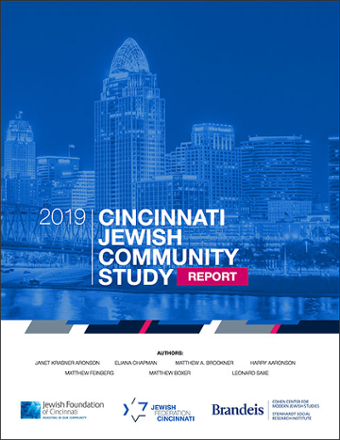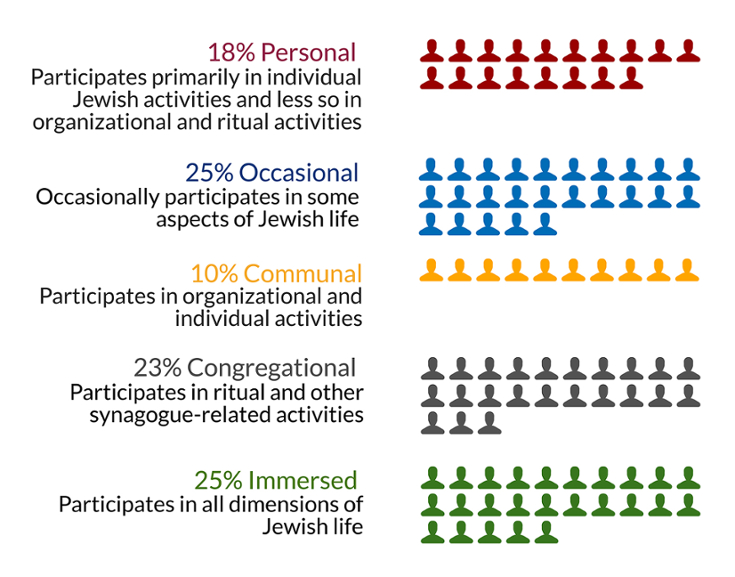2019 Cincinnati Jewish Community Study
Janet Krasner Aronson, Eliana Chapman, Matthew A. Brookner, Harry Aaronson, Matthew Feinberg, Matthew Boxer, and Leonard Saxe
January 2020
 The 2019 Greater Cincinnati Jewish Community Study estimates the number of Jewish adults in the community and the number of non-Jewish adults and children who are part of those households. The study also creates a comprehensive portrait of the characteristics, attitudes, and behaviors of that population. The study provides national and historical context by considering trends and data in the United States and where possible, comparisons to Greater Cincinnati in 2008.
The 2019 Greater Cincinnati Jewish Community Study estimates the number of Jewish adults in the community and the number of non-Jewish adults and children who are part of those households. The study also creates a comprehensive portrait of the characteristics, attitudes, and behaviors of that population. The study provides national and historical context by considering trends and data in the United States and where possible, comparisons to Greater Cincinnati in 2008.
Download public dataset (.zip)
Key Findings:
Demographics
• The 2019 Cincinnati Jewish Community Study estimates that there are 18,900 Jewish households in Greater Cincinnati. These households include 32,100 Jewish individuals and a total of approximately 48,200 adults and children.
• Twelve percent of Jewish households have a member who identifies as LGBTQ. Five percent of households include someone who is a person of color, Hispanic, or Latino. Four percent of households include an Israeli citizen. Nine percent of households include someone who is Russian speaking or was raised in a Russian-speaking home.
Inmarriage, intermarriage, and Jewish children
• Among all Jewish households in Greater Cincinnati, 76% include a couple who is married or partnered. About one-third (31%) of Jewish households include minor children.
• Fifty-nine percent of children are being raised by intermarried parents.
• Among those in interfaith relationships, 50% find the local Jewish community somewhat or very supportive to interfaith couples.
Jewish engagement
• Cincinnati Jewish adults have multiple avenues for expressing their Jewish identities.
• Four-in-five Cincinnati Jewish adults say that Judaism is part of their daily life, and 28% say it is very much part of their daily life.
• A typology of five patterns of Jewish behavior illustrates that Jewish adults participate in individual, organizational, and ritual aspects of Jewish life.
Jewish children and Jewish education
• Among the 10,200 children who live in Greater Cincinnati Jewish households, there are 5,700 children (56% of all children) who are being raised Jewish in some way, either by religion, as secular or cultural Jews, or as Jewish and another religion.
• Twenty-eight percent of children being raised Jewish in some way are enrolled in formal Jewish education.
• In summer 2018, 15% of Jewish children in grades K-12 attended Jewish day camp, and 15% attended an overnight Jewish camp.
• Twenty-five percent of Jewish students in grades 11 and 12 traveled to Israel on a peer trip.
Synagogues
• Twenty-eight percent of Jewish households are members of a synagogue or other worship community.
• Sixty-two percent of Jewish adults attended services at least once in the past year, and 18% attended a service monthly or more.
Jewish organizational life
• One third (35%) of Jewish adults volunteered with a Jewish organization, and 55% donated to a Jewish organization in the past year.
Community connections
• Seventy percent of Jewish adults feel at least a little connected to the local Jewish community, and 15% feel very connected.
• Almost half (47%) of Jewish adults feel that their current level of connection is just right, but almost half of Jewish adults would like to be more connected to the local Jewish community.
• Among those who desire more connection to the Jewish community, almost three quarters (71%) of these individuals feel that not knowing many people in the Jewish community is a condition that limits their participation.
Financial and health conditions
• Among Greater Cincinnati Jewish households, 11% describe their standard of living as “just getting along,” a possible indication of economic vulnerability, 1% said they are “nearly poor,” and less than 1% indicated they are “poor.”
• Forty-nine percent of Jewish households describe their standard of living as “living reasonably comfortably,” 31% as “very comfortably,” and 9% as “prosperous.”
• Seventeen percent of Jewish households include at least one person whose work, schooling, or general activities are limited by some sort of health issue, special need, or disability.
Index of Jewish Engagement
